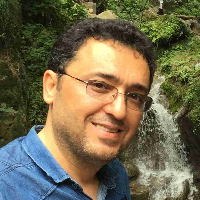Application of Multivariate Statistical Techniques to Assess Seasonal Variation in Water Quality Parameters in Gorganrood Watershed, Iran
Author(s):
Abstract:
Nonpoint source (NPS) pollution is a major surface water contaminant commonly caused by agricultural runoff. The purpose of this study was to assess seasonal variation in water quality parameters in Gorganrood watershed (Golestan Province، Iran). It also tried to clarify the effects of agricultural practices and NPS pollution on them. Water quality parameters including potassium، sodium، pH، water flow rate، total dissolved solids (TDS)، electrical conductivity (EC)، hardness، sulfate، bicarbonate، chlorine، magnesium، and calcium ions during 1966-2010 were evaluated using multivariate statistical techniques. Multivariate analysis of variance (MANOVA) was implemented to determine the significance of differences between mean seasonal values. Discriminant analysis (DA) was also carried out to identify correlations between seasons and the water quality parameters. Parameters of water quality index were measured through principal component analysis (PCA) and factor analysis (FA). Based on the results of statistical tests، climate (freezing، weathering and rainfall) and human activities such as agriculture had crucial effects on water quality. The most important parameters in differentiation between seasons in descending order were potassium، pH، carbonic acid، calcium، and magnesium. According to load factor analysis، chlorine، calcium، and potassium were the most important parameters in spring and summer، indicating the application of fertilizers (especially potassium chloride fertilizer) and existence of NPS pollution during these seasons. In the next stage، the months during which crops had excessive water requirements were detected using CROPWAT software. Almost all water requirements of the area’s major crops، i. e. cotton، rice، soya، wheat، and oat، happen in the late spring until mid/late summer. According to our findings، agricultural practices had a great impact on water pollution. Results of analysis with CROPWAT software also confirmed this conclusion.
Keywords:
Language:
Persian
Published:
Iranian Journal of Applied Ecology, Volume:2 Issue: 6, 2014
Pages:
53 to 63
https://www.magiran.com/p1277756
سامانه نویسندگان
مقالات دیگری از این نویسنده (گان)
-
Utilization of Fourier Transform and Landscape Metrics for Landscape Health Assessment
Niloufar Islamzadeh *, Alireza Mikaieli Tabrizi, Abdolrassoul Salmanmahiny, Rasul Ghorbani
Environmental Researches, -
Investigation of the distribution of plant species for systematic mapping of urban habitats with an ecological approach (Case study: Districts 9 and 11 of Mashhad City)
Raziyeh Donyavi, Alireza Mikaeili Tabrizi *, Abdolrasoul Salmanmahini, Azadeh Karimi
Journal of Environmental Studies, -
Developing a Framework for Planning Recreational Areas Using Recreation Opportunities Spectrum
Somayeh Galdavi *, Marjan Mohammadzadeh, Majid Makhdoum, , Abdolrasoul Salman Mahiny
Journal of Sustainable Earth Trends, Jan 2025 -
A Quantitative Assessment of The Impacts of Agricultural Development, With A Focus on Food Security and Desertification Risk in The Balajam Plain of Torbat Jam County, Khorasan Razavi Province
Mostafa Rezvanimoghadam, Morteza Akbari *, Mozhgan Sabet Teimouri, Shojaat Zare
Desert Management, -
Zoning of natural hazards for identify the vulnerable parts of the gas feeding network in Golestan province
Pouya Kianoosh, *, Abdolrassoul Salmanmahiny, Hamidreza Kamyab, Sepideh Saeidi
Geographical Planning of Space Quarterly Journal, -
Desertification Risk Assessment and Providing Management Strategies using the DPSIR-M Model in Khorasan Razavi province
Morteza Akbari *, Mahboobeh Sarbazi, Ali Sibevei, Somayeh Fadaei
Journal of Geography and Environmental Hazards,




